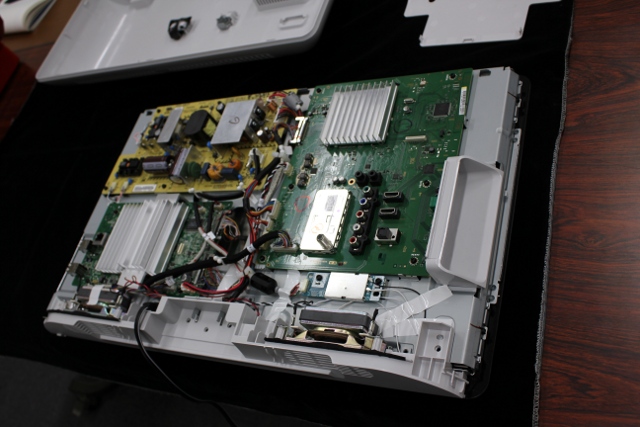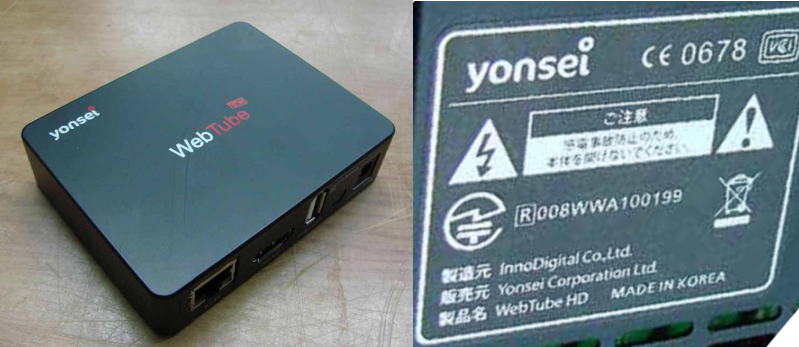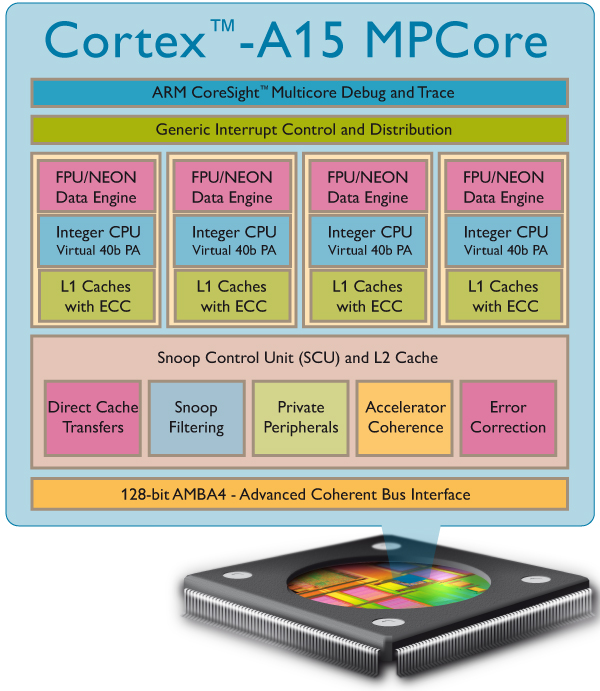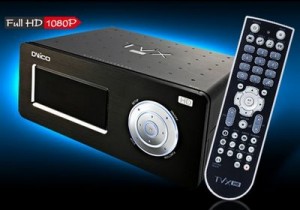In some cases, you may need to know your public IP or the public IP of a server behind a NAT (e.g. for remote SSH login) if the IP is assigned dynamically as is the case for PPPoE connections. Here are several ways to find your public IP in Linux using the shell. 1. Using curl (almost too simple) curl -s http://www.whatismyip.org 2. Using wget wget -q -O – checkip.dyndns.org|sed -e ‘s/.*Current IP Address: //’ -e ‘s/<.*$//’ 3. Using lynx lynx -dump checkip.dyndns.org If you have access to a web browser, you can simply use http://www.whatismyip.org, http://checkip.dyndns.org or http://www.moanmyip.com.
Sony NSX-24GT1 Google TV Tear Down
Nikkei Electronics has recently teared down Sony Google TV as seen at IFA 2010. They used Sony NSX-24GT1, a 24″ internet HD television powered by Google TV, for this little exercise. They found three boards: Power supply board at the upper left. Main board (“Android board”) at the lower left. TV board at the right. The SoC mounted on the TV board is Renesas Electronics Corp. EMMA3TL2 (MC-10157), an image processing SoC designed for digital TVs supporting ATSC (USA), DVB (Europe) and ARIB (Japan). Finally, they disassembled the TV to access the main board. It turned out that Sony NSX-24GT1 Google TV main board is based on Intel Atom CE4100 (center) and Foxconn is the manufacturer (lower right). Eight Samsung K4B1G0846F DRAM modules are mounted on the board (Right of Atom CE4100) and since each of the DRAM has a capacity of 128 Megabytes, the total memory capacity is 1 […]
Webtube HD Casing, Hardware and FCC Approval
WebTube HD – one of the first Android set-top box – now commercialized in Germany, Austria and Switzerland (Retail price: 249 Euros), just passed FCC approval. The interesting part of the FCC Approval is that we do get the external and internal pictures, so we can get a better look at the hardware. First let’s have a look at Webtube HD Casing. As we already knew, this media player is designed and manufactured by InnoDigital Co. Ltd. The news is that it will be distributed by Yonsei Corporation Ltd, a rather recent Japanese Company apparently only setup to promote Webtube HD. (Japanese name: ブラウザBOX) See Webtube HD internal pictures for FCC approval below. We already knows the following HW specs from Webtube HD website: OS : Android Memory : 512 Mbyte DDR / 2 Gbyte Flash Memory USB(option) : 1 port (for option) Audio : MPEG-1 layers 1,2 and 3(MP3) […]
ARM Techcon 2010 Proceedings and Presentation Slides
A lot have been covered at ARM Techcon 2010. I’ve blogged a few articles about ARM Techcon 2010, but there is a lot more to discover. A full set of documents and presentation slides shown at Techcon 2010 are available at http://vault.eetimes.com/armconference/proceedings/ The documents are divided in 2 main parts: Day 1: Chip Design Conference Day 2-3: System & Software Design Conference which are then divided into sub-directories with really (hmm) good names such as ATC-100, ATC-101… to ATC-165 so that everybody can clearly see what the subjects are. You’ll also have the Keynote and Industry addresses. Since this blog is more related to “System & Software Design” I’ve been through the pain of downloading all documents of this section and checking the subjects. You may do it for “Chip Design Conference” if you wish, I’m sure you’ll enjoy it. You’ll have one or two documents in each folder. If […]
ARM’s Next Generation Processor: Cortex A15 with Mali T-604
This year and next, many products will use processors based on ARM core cortex A8 and A9 tied-up with Mali 400 GPU. Those processors will run between 1 and 2 GHz. Earlier this month, ARM announced their new GPU Mali-T604 that will be used with Cortex A15 @ 1 to 2.5 GHz depending on the target application. The core design is ready, silicon foundries should be able to manufacture chips by the end of 2011 and products should be available for retail end of 2012 / beginning of 2013. ARM and their customer target the following applications for Cortex A15: Advanced Smartphones (1 to 1.5 GHz single or dual-core configurations) Mobile Computing (1 to 1.5 GHz single or dual-core configurations) High-end Digital Home Entertainment (1 to 2 GHz dual-core or quad-core configurations) Wireless Infrastructure (1.5 to 2.5 GHz quad-core, octo-core or larger configurations) Low-power Servers (1.5 to 2.5 GHz quad-core […]
SMP8656 Android STB Divco Tvix Xroid A1
[ad#Google Adsense – Wide Banner] At last, it seems an Android set-top box based on Sigma Designs SMP865x is going to hit the market soon, most probably Q1 2011. Divco – a Korean company – will bring Tvix Xroid A1 to market. Here are some extracts of the press release: Sigma Designs (Nasdaq: SIGM), a leading provider of system-on-chip(SoC) solutions used to deliver entertainment and control throughout the home, today announced its SMP8656 Secure Media Processor™ will enable the new Android-based Over the Top (OTT) media player by Dvico. The TVIX Xroid A1 is the first Android connected media player on the market to use Sigma’s cutting edge media processor to deliver premium quality video and music streaming services. …. Dvico’s upcoming “Android TVIX” supports all the multimedia functionalities of current TVIX, as well as native Web-browsing and downloading of Android applications. It will offer open API that can be […]
Android Debugging on MIPS Platform with Viosoft Arriba Debugger
I’ve recently attended a webinar organized by EETIMES with MIPS and Viosoft entitled “Android Platform: It’s Not Just For Handsets Anymore” on the 26th October 2010. You can now register for the on demand version at http://seminar2.techonline.com/s/mips_oct0610 The purpose of this web conference was to explain the status of Android for Set-top-box and MID development, the complexity of debugging kernel, java and application in an Android system as well as showcasing Viosoft Arriba to debug Android on MIPS. If you ever develop Android on Sigma Designs SMP864x/SMP865x platforms you’ll probably use Viosoft Arriba. You may refer to the following material Comprehensive Development and Debug Coverage for Linux and Android on the MIPS Architecture that contains the slides used during the presentation. Rick Leatherman – Vice President, Development Tools at MIPS Technologies, Inc – firstly described Android architecture with the application level, Library/Android (Dalvik), and the kernel. He then explained the […]
See-through OLED & LCD Displays
Samsung Electronics and LG exhibited see-through LCD displays and Samsung Mobile Display see-through OLED displays at FPD (Flat Panel Display) International 2010/Green Device 2010, Chiba City, Japan. Samsung Electronics brought 2 different displays 23 inch and 46 inch LCD displays while LG Display showcased a 47-inch LCD display. See-through displays use natural light as backlight during the day and use a transparent backlight system attached to the back of the panel during the night. Samsung Mobile Display exhibited 2 OLED displays (14 inch and 19 inch). The main applications of such displays can be: Digital signage. This is the number 1 application for such displays. You could have a real product at the back and the see-though display at the front displaying some product info and/or promotional videos. In the picture below, Samsung created a setup with real wine bottles and grapes in the background and a see-through display in […]













